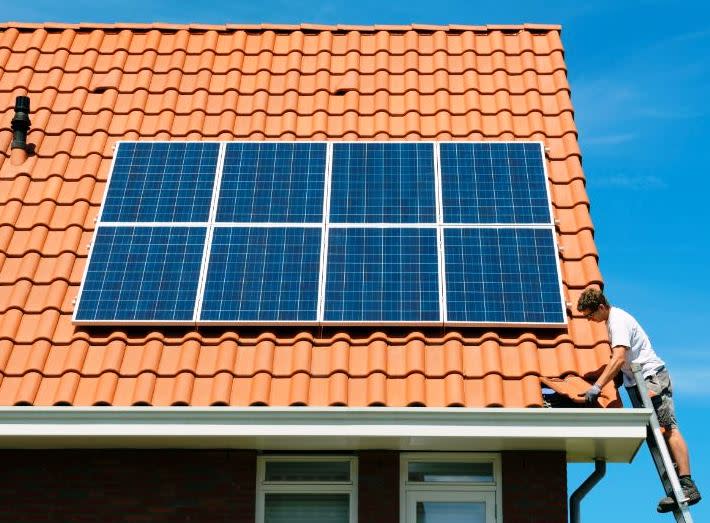Growing energy demand doesn’t mean abandoning transition

Electricity demand has been flat for decades and with new demand forecasts showing annual load or demand growth of up to 6% in some regions, some are sounding the alarm. (Getty Images)
Technologies and opportunities abound to add clean electric power to our communities and fuel growth in our economy. Indiana is seeing a birth of new industry such as battery manufacturing with over $6 billion investment and over 2,800 jobs created by Stellantis and Samsung SDI in Kokomo, solar panel manufacturing in Jeffersonville and Indianapolis bringing over 1,400 jobs, EV assembly in Princeton Indiana by Toyota will bring $1.4 billion in investment and there is a growth in demand for datacenters that will bring billions more of investment to our state.
Electricity demand has been flat for decades and with new demand forecasts showing annual load or demand growth of up to 6% in some regions, some are sounding the alarm. Bottlenecks created by interconnection delays and transmission capacity contribute to the challenges of meeting growing demand. However, we can and should maintain our states commitment to the five pillars of electricity generation which are environmental sustainability, resilience, affordability, stability and reliability. We can do it even when it’s challenging.
What is the solution? There are many and one place to start is to add capacity at the edge of the grid in our towns and in our homes. This is referred to as Distributed Energy Resources (DER’s) and you can think of it as many smaller sources of clean energy output rather than large, centralized generation. What are the advantages to this approach?
The transmission grid is bypassed altogether avoiding extra strain and capacity bottlenecks. This reduces the need for costly investment for our transmission system that can carry power hundreds of miles as needed. It also bypasses interconnection ques that can take years to gain approval. DER’s bring reliable power to Hoosiers measured in months not years. DER’s save both time and money.
Community solar, when established through legislation, allows energy operators to sell power to households and businesses at a discount. They do this through a subscription that can lead to savings of up to 20% on electric bills. Community solar provides power at the local level and this power supports peak demand on sunny afternoons when our air conditioners are blasting. Retailers, small manufacturers, apartment dwellers, low income households and more are especially geared to benefit from this clean affordable energy option.
Some utilities in states including Texas and Arizona have found it cost effective to incentivize home battery storage as a way to reduce grid demand. Batteries are linked remotely to push energy into homes during key times when demand is high to “shave peak load” which essentially means reduce demand strains on the grid. Homeowners have added security of knowing they have a reliable backup power source when power is interrupted. Severe whether and storms are the leading source of power outages. Having backup battery power in your home can keep the lights on for Hoosiers.
Rooftop solar has many barriers to success in our state since the general assembly passed Senate Enrolled Act 309 which killed net metering and vastly reduced the value of rooftop solar. It doesn’t have to be that way. Utilities can build a tariff that values local clean power on rooftops and incentivizes homeowners to make that investment. By doing so, they can shave peak load and add much needed power to our grid quickly.
Coal industry advocates have seized on energy demand concerns to promote a future that involves burning more coal. This approach does not serve Hoosiers well. Coal is costly and subjected to necessary EPA rules aimed at protecting our air quality and protecting our drinking water, further increasing the cost of coal. Indiana’s investor-owned utilities, with the exception of Duke Energy, are working to move away from coal. They see a reliable path forward that phases it out within the next decade or sooner. New investment in coal detracts from cleaner energy sources and places an undue burden on Hoosier rate payers.
Furthermore, the “explosive” growth of datacenters energy demand could be overstated. In Georgia, Microsoft is pushing back against investment in new fossil fuel assets to support load growth. They are concerned that utilities are over forecasting demand and are relying too heavily on carbon intensive fuel forms to meet this growth. Additionally, big tech is fiercely competing to lead in artificial intelligence (AI). With connection ques backed up and supply chains delayed, big tech is rushing to secure their positions by establishing datacenters wherever possible. This race may lead to exaggerated growth projections. Implementing data center curtailment agreements with utilities and improving data center operations efficiency are two examples of solutions that manage load and reduce the need for new generation.
Indiana is experiencing an energy transition that brings immense opportunity and some challenges as well. We need to be smart and thoughtful about how we proceed. Affordable and clean energy options along with creative load management systems exist that will help us move away from costly and dirty energy sources. Don’t be fooled by those that say we need to go backwards to meet the opportunities of our future. Instead let’s move forward with speed and care and embrace the transition to clean, renewable and affordable energy.
GET THE MORNING HEADLINES DELIVERED TO YOUR INBOX
The post Growing energy demand doesn’t mean abandoning transition appeared first on Indiana Capital Chronicle.

